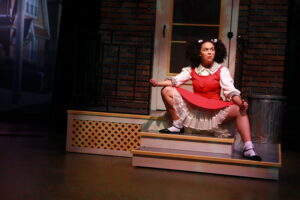Rich, evocative writing and Lauren Steele’s vibrant performance highlight a winning one-woman play at Clackamas Rep.
 Over the course of decades writing about performing arts in Portland, I have come to recognize a certain sort of experience that I refer to as a “black dot show.” This is when I happen to glance around at the audience and notice that I am the black dot amid an auditorium full of white people. As a Portland native, I find these occurrences neither surprising nor uncomfortable.
Over the course of decades writing about performing arts in Portland, I have come to recognize a certain sort of experience that I refer to as a “black dot show.” This is when I happen to glance around at the audience and notice that I am the black dot amid an auditorium full of white people. As a Portland native, I find these occurrences neither surprising nor uncomfortable.
On a second scan of the crowd at Clackamas Repertory Theatre this weekend, I spotted a young family in the back row that tilted the melanin equation a bit, but I already was musing about the company’s choice to stage “Queens Girl in the World” — a play about black adolescence and identity in early-1960s New York — for what I would guess is the oldest and whitest audience among Portland-area theaters.
I’m not the only person to find the choice surprising. In an unusually personal program note, the playwright, Caleen Sinnette Jennings, recalls her initial inclination to deny Clackamas Rep’s request for performance rights: “I pulled up your website and here’s what I saw: both of you (artistic director David Smith-English and managing director Cyndy Smith-English) are white. Your past theatrical seasons were white. Your theatre is located in a white community. You are outside of the City of Portland. Enough said.” But a follow-up phone call and a chance visit changed her mind.
“I should have remembered that embracing with curiosity, empathy and love the stories of those who look like ‘the other’ is the very definition of the theatrical impulse,” she wrote. “Silly me. How could I have forgotten that the more specific our stories, the more universal their themes?”
From the moment that Lauren Steele steps onstage as 12-year-old Jaqueline Marie Butler, all bright-eyed innocence and pin-point-polite diction, specificity is the hallmark of this terrific production. Written with abundant heart and loads of evocative detail, performed with winning vibrance, “Queens Girl” draws us in and charms us from the outset, then brings us along on a journey of surprising scope, depth and, yes, universality.
We meet Jacqueline — or Jackie, as she’s mostly called — on the stoop of her family’s two-story detached brick house in a neat but modest part of Queens, serenaded by the roar of planes on their descent to LaGuardia Airport. She comes across as sweet and sheltered. It’s quickly apparent that she’s hard at work, navigating and negotiating a path between the exacting uplift-the-race standards of her parents and the looser culture of the surrounding neighborhood. Her mother is a stickler for propriety, in speech and manners, such a model of Negro grace and bearing that Jackie refers to her not as “Mom” but as “Grace Lofton Butler.” By contrast, Persephone — a neighbor girl who is growing up a bit faster and less inhibited than Jackie — says things such as, “James ain’t feel me up! He jus’ kiss on me lil’ bit.”
It might seem at first that we are in for an engaging, lighthearted coming of age story. Jackie looks forward to confirmation classes at church, because her Grace will let her trade in her kid’s anklets for real stockings. When Grace begins talking tactfully of “womanly cycles,” Jackie is half puzzled, half excited: “Am I getting a bike?!” she wonders. Jackie’s social development briefly gets airborne with her first crush/kiss, then is blown off course when her parents transfer her from PS 124 to a private school in Greenwich Village, where suddenly she’s a black dot.
All of this is easy to enjoy and easy to relate to, regardless of the racial/cultural specifics — Jackie’s or those of any audience member.
Steele is a wonderfully winning performer, and versatile to boot. (The program lists 13 roles portrayed by Steele, but as is often the case with such shows, this really is a single character telling us a story. While young Jackie vividly recreates the distinctive speech and mannerisms of the people in her life, we see these others strictly from her perspective, which is sometimes sensitive, sometimes broadly comic.) Director Damaris Webb has shaped the production with a sure and easy rhythm and unfussy, solidly supportive design work (Haley Hurita’s projections are especially effective). And Jennings’ writing is studded with descriptive gems: Jackie says her mother has a voice like “twilight-colored taffeta,” sketches an image of her proud West Indian father with his “dimples and brushed mustache,” and swoons at the 15-year-old boy whose recently changed voice sounds like “melting butter in a skillet.”
What ultimately elevates “Queens Girl in the World,” though, is the “in the world” part. By gradual, graceful, deceptively significant steps, Jennings builds her story (“semi-autobiographical,” according to Webb’s director’s note) outward from that unassuming front stoop, taking in larger ideas and events: the pros and cons of cultural assimilation, gradualism versus radicalism in politics, the tricky relationship of social-justice allies, the complex overlays of racial/economic/ideological identity, the cascading cataclysms of the march on Washington, the Birmingham church bombing, and the assassinations of John F. Kennedy and Malcolm X. As she is at the outset, toggling between Persephone’s street vernacular and her mother’s textbook English, through all the growth and change and turmoil and learning Jackie repeatedly finds herself in complicated social dynamics, facing contradictory expectations, having to construct and calibrate an identity that fits herself and her situation.
In that regard, maybe Jackie’s neither black dot nor black sheep, as much like any of us as different from us — not just a Queens girl in the world, but a chameleon riding a rainbow.
